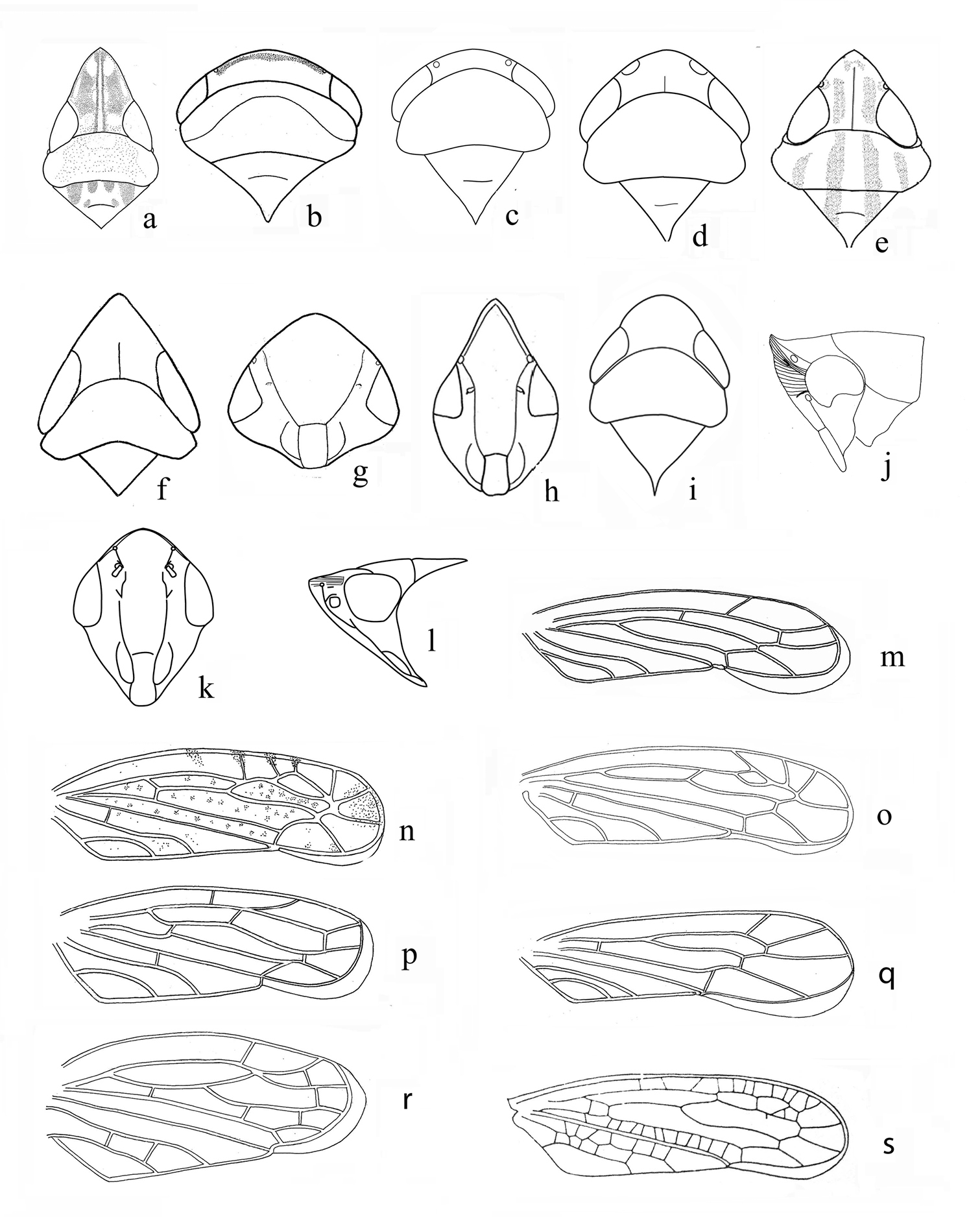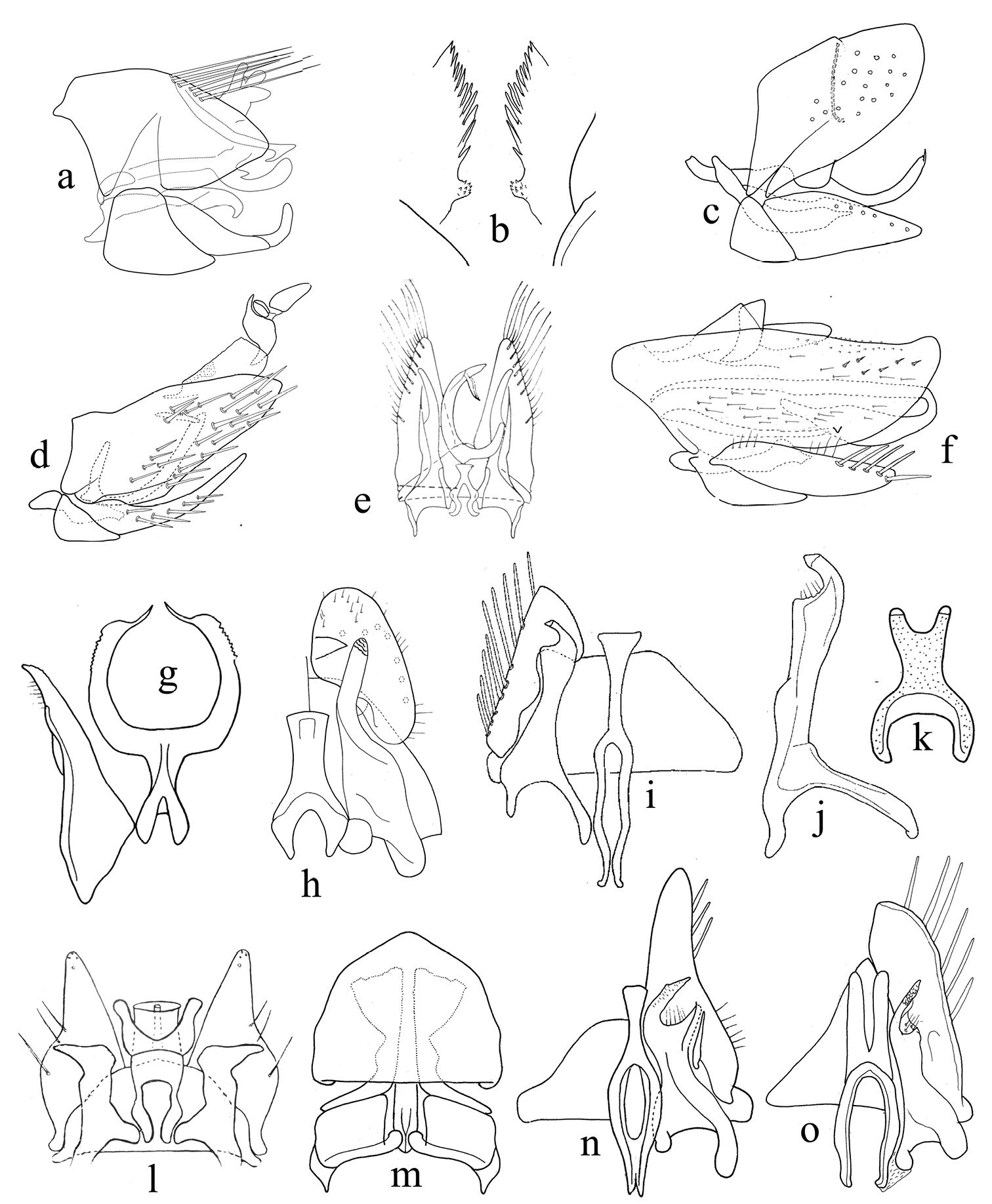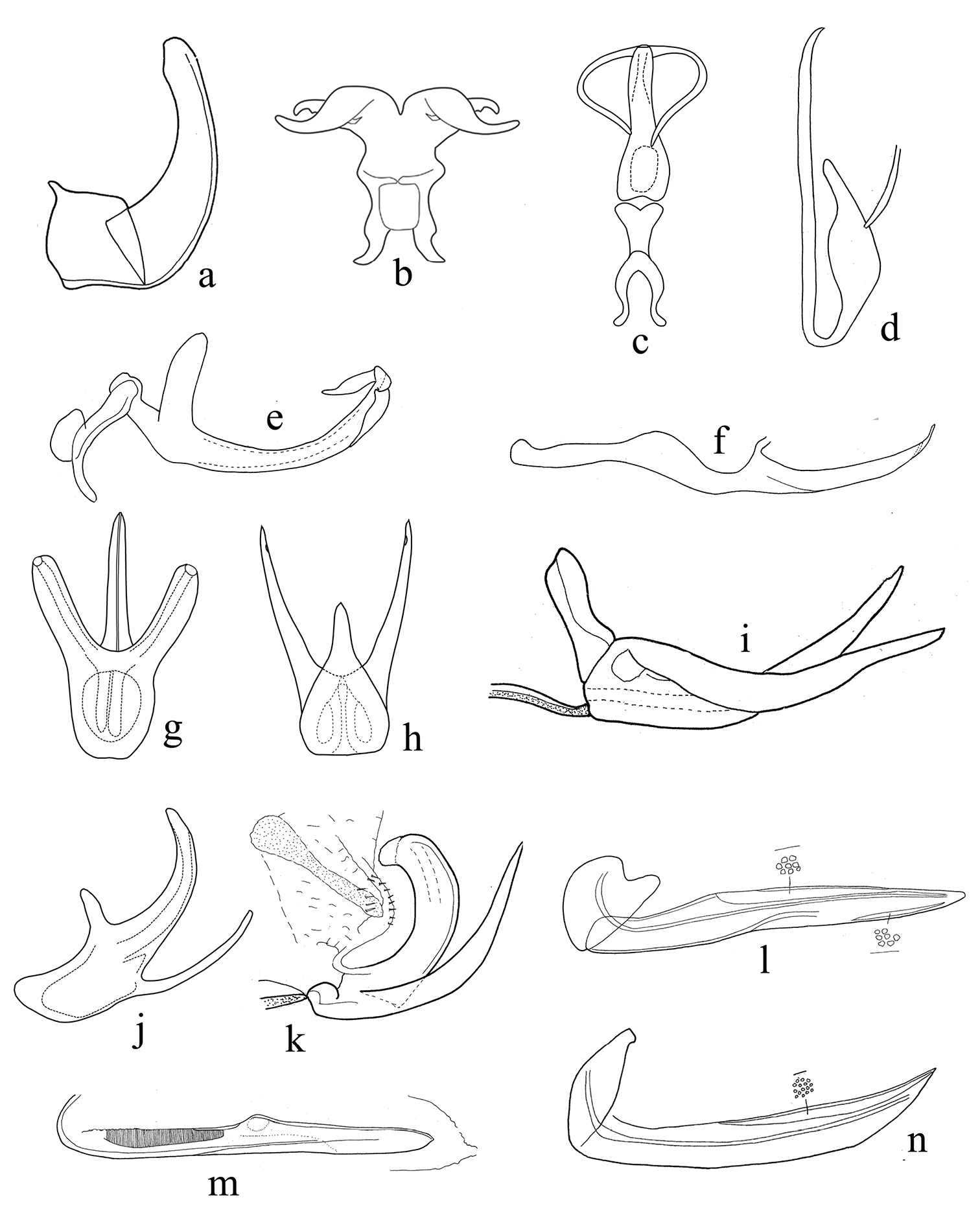(C) 2011 Imran Khatri. This is an open access article distributed under the terms of the Creative Commons Attribution License, which permits unrestricted use, distribution, and reproduction in any medium, provided the original author and source are credited.
For reference, use of the paginated PDF or printed version of this article is recommended.
A key with accompanying figures is provided for the 14 tribes and 35 genera of Deltocephalinae (Cicadellidae) from Pakistan.
Deltocephalinae, taxonomy, morphology
Deltocephalinae is the largest and most diverse subfamily of Cicadellidae with 6200 described species placed in over 850 genera (
Early leafhopper taxonomic work in Pakistan (from 1960 onwards) focused on Typhlocybinae. Work on Deltocephalinae was scattered in various publications (
In the present paper we revise the above tribal key to include Mukariini, following its recent discovery in Pakistan (
An additional genus and species, omitted by
One other species, Hengchunia pakistanica
In total 35 known genera are included in the key. Figures are also provided and additional figures can be found in
Note: The characters given in the key will separate the Pakistan genera but not necessarily the tribes on a wider distribution. As the genera in the following key are grouped by tribe and as some of these are based only on the male genitalia, several genera in the latter part of the key are based only on the male.
| 1 | Anterior margin of head with transverse striations or carinae (Figs 1j, l) | 2 |
| – | Anterior margin of head smooth or shagreen | 7 |
| 2 | Clypellus elongate, extending beyond margin of genae, tapered to apex and slightly bent subapically under head. | (Grypotini).....3 |
| – | Clypellus short not extending beyond margin of genae | 4 |
| 3 | Vertex of head medially longer than next to eyes; ocelli equidistant between eye and median line of head; 5–6 mm in length | Sohipona Ghauri & Viraktamath |
| – | Vertex of head of uniform length; ocelli placed slightly closer to eye than to median line; less than 5 mm in length | Pinopona Viraktamath & Sohi |
| 4 | Antennae very long, extending beyond midlength of body, situated at upper corner of eyes (Fig. 1k) | Drabescini (Paraboloponina) Dryadomorpha Kirkaldy |
| – | Antennae short, not reaching midlength of body, situated below upper corner of eyes | 5 |
| 5 | Ocelli on foremargin of head bound both dorsally and ventrally by at least one carina (fig. 1j) | 6 |
| – | Ocelli located before foremargin of head, with carinae only ventrally | Penthimiini Penthimia Distant |
| 6 | Head depressed anteriorly (Fig. 1j); forewing venation reticulate; aedeagus with one shaft | Penthimiini Neodartus Melichar |
| – | Head not depressed anteriorly, forewing venation not reticulate; aedeagus with two shafts (Fig. 3b) | Mukariini (Mukaria Distant) |
| 7 | Robust species; vertex distinctly broader than long and only slightly longer medially than next to eyes (Fig. 1b); forewing appendix extending to outer apical cell (Fig. 1r); subgenital plates fused to each other and to valve (Fig. 2m); style apical process expanded apically; aedeagus fused to connective (Fig. 3e) | Goniagnathini (Goniagnathus Fieber) |
| – | Without the above combination of characters | 8 |
| 8 | Genae of face broad (Fig. 1h), visible in dorsal view (Fig. 1a). | Scaphytopiini.....9 |
| – | Genae of face narrow, not visible dorsally | 11 |
| 9 | Forewing obliquely truncate at apex; green species with red longitudinal stripes on head, thorax and forewings (Fig. 1e) | Varta Distant |
| – | Forewing rounded at apex (Fig. 1o); colour not as above | 10 |
| 10 | Pronotum with lateral carina | Grammacephalus Haupt |
| – | Pronotum without lateral carina | Masiripius Dlabola |
| 11 | Face with laterofrontal sutures directed mediad of and terminating distad of corresponding ocelli (Fig. 1g). Head, particularly in female, somewhat spatulate. Ovipositor with second valvulae, lacking teeth (Fig. 3l). | Hecalini.....12 |
| – | Without the above combination of characters | 13 |
| 12 | Green species, male pygofer without caudal marginal stout setae (Fig. 2d) | Hecalus Stål |
| – | Brown species; male pygofer with caudal marginal stout setae | Glossocratus Fieber |
| 13 | Vertex narrow basally (Fig. 1f). Male pygofer elongate, without a membranous laterobasal slit, with a lateroposterior triangular process (Fig. 2f); valve long; subgenital plate short; connective with stem two pronged apically, arms parallel (Fig. 2o); aedeagal shaft whip-like (Fig. 3d). Ovipositor with second valvulae lacking teeth (Fig. 3m) | Stenometopiini (Stirellus Osborn & Ball) |
| – | Without the above combination of characters | 14 |
| 14 | Forewing brachypterous or if macropterous then appendix (when present) extending to fourth (outer) apical cell (Fig. 1m). Aedeagal shaft hinged (Fig. 3a) or not hinged; connective with arms looped (Fig. 2n). Ovipositor with sculpture granular, not extending to dorsal margin (Fig. 3n). | Chiasmini.....15 |
| – | Forewing appendix extending to second apical cell (Fig. 1n). Aedeagal shaft not hinged; connective with arms looped or divergent. Ovipositor with sculpture reticulate, extending to dorsal margin | 19 |
| 15 | Forewing with two subapical cells (Figs 1m) | Aconurella Ribaut |
| – | Forewing with three subapical cells (Figs ln, o) | 16 |
| 16 | Head margin depressed in lateral view | 17 |
| – | Head margin rounded in lateral view | 18 |
| 17 | Forewing lacking appendix. Aedeagal shaft not hinged at base with atrium; compressed in apical region with serrated margin | Gurawa Distant |
| – | Forewing when well developed, with appendix. Aedeagal shaft hinged at base with atrium (Fig. 3a), shaft cylindrical and lacking serration | Chiasmus Mulsant & Rey |
| 18 | Predominantly green species | Nephotettix Matsumura |
| – | Predominantly pale brown species | Exitianus Ball |
| 19 | Forewing with two subapical cells (Fig. 1q). Connective with arms divergent. | Macrostelini.....20 |
| – | Forewing with three subapical cells (Fig. 1n, o), sometimes outer subapical cell subdivided (Fig. 1s), or if two subapical cells connective with arms convergent apically | 22 |
| 20 | Vertex of head short, of uniform length, more than 4 times wider than long (Fig. 1c) | Balclutha Kirkaldy |
| – | Vertex longer medially than next to eyes, twice or less as wide as medial length | 21 |
| 21 | Head and thorax golden yellow, vertex with two round dark brown spots (Fig. 1d). Male pygofer with long, slender hook-like process; without marginal comb-like serrations (Fig. 2a) | Cicadulina China |
| – | Head and thorax not as above. Male pygofer without above process; with comb-like serrations on caudal margin (Fig. 2b) | Macrosteles Fieber |
| 22 | Aedeagus with two shafts. | Opsiini.....23 |
| – | Aedeagus with one shaft | 25 |
| 23 | Aedeagal shafts fused in basal half, then divergent describing a circle (Figs 3c) | Neoaliturus (Circulifer) Distant |
| – | Aedeagal shafts separate at base (Figs 3g, 3h) | 24 |
| 24 | Aedeagal shaft with ventral pair of processes (Figs 3g, 3j) | Opsius Fieber |
| – | Aedeagal shaft without ventral pair of processes (Fig. 3h) | Orosius Distant |
| 25 | Connective with arms divergent (Fig. 2k). | Athysanini.....26 |
| – | Connective with arms at most only divergent basally, convergent apically | 32 |
| 26 | Vertex acutely pointed, disc depressed; forewing venation reticulate (Fig. 1s) | Platymetopius Burmeister |
| – | Vertex and forewings not as above | 27 |
| 27 | Three to four cross veins from outer apical cell reaching costal margin (Fig. 1n) | 28 |
| – | At most two cross veins from outer apical cell reaching costal margin | 29 |
| 28 | Male connective with paraphyses (Fig. 2g) | Scaphoideus Uhler |
| – | Male connective without paraphyses (Fig. 2k) | Bampurius Dlabola |
| 29 | Male subgenital plates with mesal sclerotized process (Fig. 2h) | Neolimnus Linnavuori |
| – | Male subgenital plates without mesal sclerotized process | 30 |
| 30 | Aedeagal shaft without basal processes, apophysis of style long, subequal to length of aedeagal shaft (Fig. 2e) | Pseudosubhimalus Ghauri |
| – | Aedeagal shaft with basal pair of dorsal (Fig. 3i) or ventral (Fig. 3k) processes, apophysis of style shorter than aedeagal shaft | 31 |
| 31 | Aedeagal shaft with basal processes arising on dorsal surface of shaft (Fig. 3i) | Monobazus Distant |
| – | Aedeagal shaft with basal process arising on ventro-lateral surface of shaft (Fig. 3k) | Osbornellus Ball |
| 32 | Connective fused to aedeagus (Fig. 3f). | Deltocephalini.....33 |
| – | Connective not fused to aedeagus (Fig. 2i). | Paralimnini.....34 |
| 33 | Vertex with transverse black stripe; pygofer with dorsal marginal appendage | Paramesodes Ishihara |
| – | Vertex without transverse black stripe; pygofer without appendage (Fig. 2c) | Maiestas Distant |
| 34 | Male subgenital plates short (Fig. 2i); mesal arm of style longer than outer arm (Fig. 2j) | Psammotettix Haupt |
| – | Male subgenital plate longer; mesal arm of style shorter than outer arm (Fig. 2l) | Jilinga Ghauri |
a–f, i (head and thorax dorsal view); g, h, k (face); j, l (head and thorax lateral view); m–s (right forewing) A Grammacephalus indicus Viraktamath & Murthy B Goniagnathus (T.) quadripinnatus Dash & Viraktamath C Balclutha incisa (Matsumura, 1902) D Cicadulina bipunctata Ghauri E Varta rubrofasciata Distant F Stirellus lahorensis (Distant) G Hecalus sindhensis (Ahmed & Aziz) H Grammacephalus indicus Viraktamath & Murthy I Mukaria splendida Distant J Neodartus acocephaloides Melichar K, L Dryadomorpha pallida Kirkaldy M Aconurella prolixa (Lethierry) N Bampurius pakistanicus Khatri & Webb O Grammacephalus indicus Viraktamath & Murthy P Chiasmus sp. Q Macrosteles indrina (Pruthi) R Goniagnathus (T.) quadripinnatus Dash & Viraktamath S Platymetopius sp.
a–o male genitalia. a, c, d, f (genital capsule); b (pygofer, caudal view); e (genital capsule, internal view); g (connective and style); h, i, n, o (valve, style and connective, dorsal view). j (style); k (connective); l (valve, styles, subgenital plates, connective and base of aedeagus); m (fused subgenital plates and valve (setae omitted), styles and base of connective). A Cicadulina bipunctata Ghauri B Macrosteles indrina (Pruthi) C Maiestas pruthii (Metcalf) D Hecalus sindhensis (Ahmed & Aziz) E Pseudosubhimalus bicolor Pruthi F Stirellus lahorensis (Distant) G Scaphoideus harlani Kitbamroong & Freytag H Neolimnus quadricornis Khatri & Webb I, J Psammotettix emarginata Singh K Bampurius pakistanicus Khatri & Webb L Jilinga gopii (Pruthi) M Goniagnathus (T.) quadripinnatus Dash & Viraktamath N Aconurella prolixa (Lethierry) O Stirellus lahorensis (Distant).
a–n male and female genitalia; a, d, g–j (aedeagus); b–c, e–f (aedeagus and connective); k aedeagus, apex of connective and pygofer; l, n (first valvulae); m (second valvulae). A Aconurella prolixa (Lethierry) B Mukaria splendida Distant C Neoaliturus (Circulifer) tenellus (Baker) D Stirellus lahorensis (Distant, 1918) E Goniagnathus (T.) quadripinnatus Dash & Viraktamath, 2001 F Maiestas tareni (Dash & Viraktamath) G Opsius versicolor (Distant) H Orosius albicinctus Distant I Monobazus dissimilis (Distant) J Opsius versicolor (Distant) K Osbornellus (Mavromoustaca) macchiae (Lindberg) L Hecalus sindhensis (Ahmad & Aziz) M Stirellus lahorensis (Distant) N Aconurella prolixa (Lethierry).
We are thankful to the Dr. C. A. Viraktamath, University of Agricultural Sciences, Bangalore, India and Mr. M. D. Webb, The Natural History Museum, London, for their help in preparation of the manuscript. We are also thankful to the authorities of Zootaxa for permission to reproduce some of the figures.









